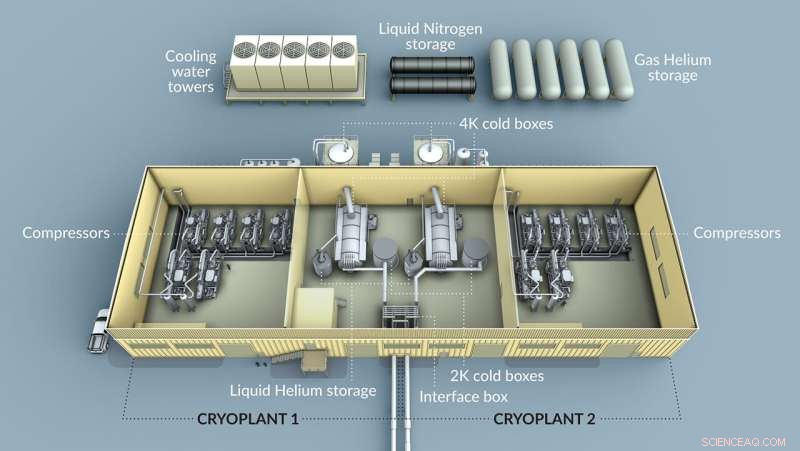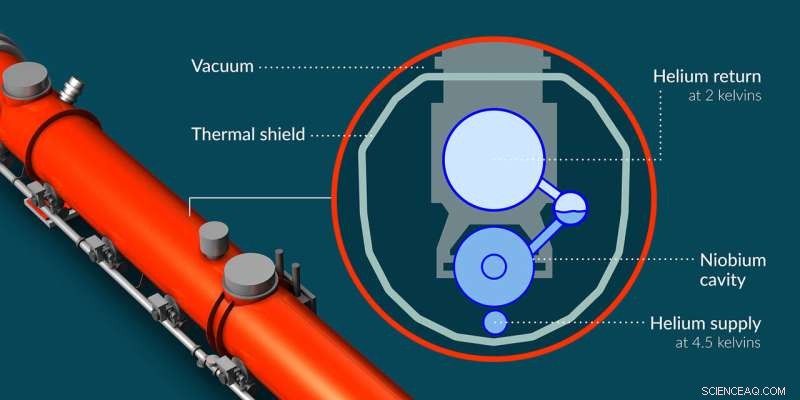
Ett schema över LCLS-II kryoplantan. Kredit:Greg Stewart/SLAC National Accelerator Laboratory
Idag tar det bara en och en halv timme att göra en supraledande partikelaccelerator vid Department of Energys SLAC National Accelerator Laboratory kallare än rymden.
"Nu klickar du på en knapp och maskinen får från 4,5 Kelvin ner till 2 Kelvin", säger Eric Fauve, chef för Cryogenic-teamet på SLAC.
Medan processen är helt automatiserad nu, tog det sex år att designa, bygga, installera och starta upp ett komplicerat system att få den här acceleratorn, kallad LCLS-II, till 2 Kelvin, eller minus 456 grader Fahrenheit.
Den ursprungliga LCLS, eller Linac Coherent Light Source, accelererar elektroner för att slutligen producera röntgenstrålar som används i atom- och molekylundersökningsexperiment. LCLS-II kommer att fungera samtidigt med LCLS. Men till skillnad från LCLS, som använder koppardelar vid rumstemperatur för att accelerera elektroner, använder LCLS-II-uppgraderingen supraledande kryomoduler. Dessa kryomoduler ger elektroner energi mer effektivt, vilket kommer att hjälpa till att generera mer kraftfulla röntgenpulser för att utöka experimentella möjligheter över fält.
Men medan LCLS kan fungera i rumstemperatur måste LCLS-II kylas till 2 Kelvin, bara 4 grader Fahrenheit över absoluta nollpunkten, för att bli supraledande.
Och det innebar att SLAC behövde ett team för att fokusera på kalla saker.
Sätta ihop ett team för att montera en kryoplanta
Innan LCLS-II svalnade fanns det ingen grupp som ägnade sig åt kryogenik vid SLAC.
"Vår största utmaning var att det här var första gången vi gjorde det här med ett nytt team," sa Fauve.
LCLS-II Cryogenic-teamet, som nu består av 20 operatörer och ingenjörer, bildades 2016 på SLAC för att bygga anläggningen som kyler acceleratorn:en kryogenanläggning.
"Det här är ett komplicerat system med många delsystem som fungerar i tandem", säger Viswanath Ravindranath, ledande kryogen processingenjör för LCLS-II.
SLAC samarbetade nära med ingenjörer från DOE:s Fermi National Accelerator Laboratory och Jefferson National Accelerator Facility samt ledande kryogenföretag för att designa och anskaffa material till kryoanläggningen.
"Detta samarbete gjorde det möjligt för LCLS-II-projektet att dra nytta av de bästa kryogena resurserna inom DOE-laboratorierna och på andra håll," sa Fauve.

Ett tvärsnitt av LCLS-II-acceleratorn som visar var flytande och gasformigt helium strömmar in och ut ur systemet. Kredit:Greg Stewart/SLAC National Accelerator Laboratory
Kryoplantan fylls med helium, som kyls och pumpas sedan till LCLS-II. Medan vartannat element fryser under 4 Kelvin kan helium förbli en vätska, och vid 2 Kelvin blir helium superfluid, vilket betyder att det flyter utan viskositet. Detta faktum, och superfluid heliums förmåga att leda värme bättre än något annat känt ämne, gör det till det perfekta köldmediet för att kyla ner en supraledande accelerator.
Innan kylningen börjar levererar trailers staplade med varmkorvformade tankar gasformigt helium vid omgivningstemperatur (cirka 300 Kelvin) till kryoanläggningens utomhuslagringstankar. Kryoplantan kräver totalt fyra ton helium.
Men detta helium kommer orent. Eventuella föroreningar kommer så småningom att frysa och täppa till systemet, så de första renarna måste fånga upp all fukt eller oönskade gaser, som kväve, för att uppnå 99,999 % helium.
Efter rening höjer kompressorer heliumets tryck. The pressure and temperature of a gas are coupled:as pressure decreases, temperature also decreases. So, while helpful later, this incidentally raises helium's temperature to 370 Kelvin.
Following compression, five large towers containing cooling water are used to lower helium's temperature back down to 300 Kelvin. The gas then enters the cryoplant's 4K cold box, which is a giant, uber-complicated helium refrigerator.
In the cold box, liquid nitrogen running 77 Kelvin knocks the helium down from 300 Kelvin to 80 Kelvin in a heat exchanger. In this device, the warm helium gas and colder liquid nitrogen travel in opposite directions while separated by a thin metal plate, transferring heat through the plate from the helium to the nitrogen. The plant uses 20 metric tons of liquid nitrogen every other day.
The helium then runs through a set of four turboexpanders. Now the initial gas-compressing step pays off:the turboexpanders expand the high-pressure gas, lowering its pressure enough to bring the helium all the way to 5.5 Kelvin.
However, the helium has more expanding to do before it can leave the cold box. It travels through a valve that has lower pressure on the other side. This lower pressure causes the gas to expand, lowering its pressure and bringing its temperature down to 4.5 Kelvin (hence the name of the 4K cold box), where it becomes a liquid.
This liquid helium is then sent through pipes to the accelerator's cryomodules, where it cools the machine to 4.5 Kelvin.
Once the 4K cold box was up and running, it took the Cryogenic team one week to cool LCLS-II from room temperature to 4.5 Kelvin, which it reached for the first time on March 28, 2022. But that's not cold enough!
Colder still
To reach 2 Kelvin, the 4.5 Kelvin helium undergoes yet another (final) expansion through a valve in the accelerator's cryomodules. Again, the lower pressure on the other side of the valve causes helium's pressure to drop. This cools helium to the goal temperature of 2 Kelvin.
Creating the low pressure inside the cryomodule is a feat in itself.
"The magic happens when it goes through that valve, but only because we have a train of cold compressors that maintains the pressure in the cryomodule at very low pressure," Fauve said. This set of five compressors stationed after the valve create the pivotal pressure difference on either side of the valve.
After months of turning on and configuring this cooling system, LCLS-II finally reached 2 Kelvin on April 15.
"Everything was possible because of all the hard work over the years from so many smart and dedicated people," said Swapnil Shrishrimal, cryogenic process and controls engineer for LCLS-II. "Being a small team, as well as a young team, we are very proud of the system we commissioned."
When the electron beam is on and being accelerated by the cryomodules, the 2 Kelvin helium will absorb heat from the accelerator, boil, and turn back into gas. That gas is injected back into the 4K cold box to help cool warmer helium.
"We don't want to waste the cooling capacity, so we try to recover as much of it as possible," Ravindranath said. The system recycles the helium, which is expensive, although essential for long-term operation.
The Cryogenic team actually built two cryoplants, which share a building, but LCLS-II only uses one. The second cryoplant will support planned upgrades to LCLS-II. When both cryoplants are on they will use approximately 10 megawatts of electrical power.
Only four other cryoplants in the United States cool this much helium to 2 Kelvin. Thomas Jefferson National Accelerator Facility and Fermi National Accelerator Laboratory, which both house cryoplants of similar magnitude, supported SLAC's design and procurement of equipment. SLAC collaborated with Oak Ridge National Laboratory, Brookhaven National Laboratory, and CERN as well.
"The years of expertise and support of our partner labs allowed us to do this," Shrishrimal said. Fauve also credits the team's success to their extensive planning and dedication. The entire Cryogenic team stayed on site during the pandemic to continue bringing the plant to life.
"Even when SLAC was shut down, if you were at the cryoplant you would not be able to tell the difference before and during COVID," Fauve said, except for the masks and social distancing, of course.
LCLS-II is expected to produce its first X-rays early next year. The Cryogenic team feels confident they will continue to run their very complicated refrigerator with ease.
"It's a pretty nice and easy operation now because everything is automated," Shrishrimal said. + Utforska vidare